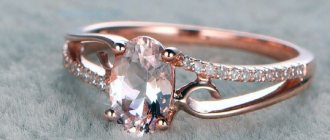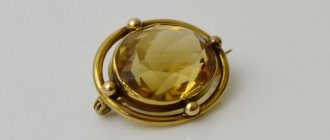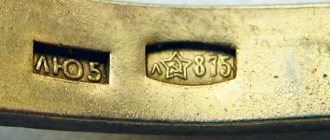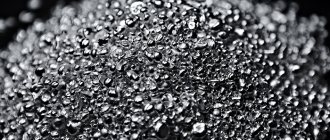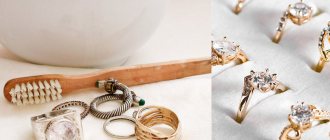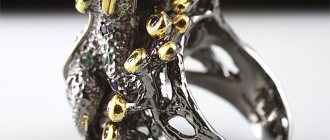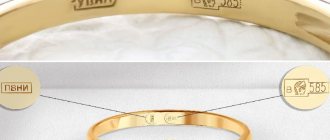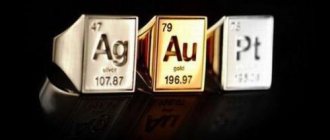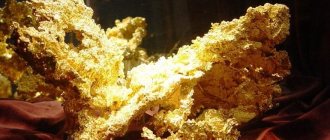In a previous article, TD Serebro talked about why some metals are considered precious. It turned out that there is a simple explanation for this: they have unique chemical, physical and aesthetic properties.
Each metal is unique in its own way, but our company treats noble silver with special respect. It became the basis of the trading house’s assortment, is one of the main metals in jewelry and is very widely in demand in light and heavy industry. There are amazing facts and several myths associated with silver - we will confirm some, dispel others, and all of this will be interesting.
Disclaimer: We do not try to tell everything, but want to give you a general understanding of those things that will be useful when choosing jewelry. We are a jewelry company. If you want to understand these issues in depth, you might want to consider special education.
Physics
Silver is a white precious metal. Its density is 10.5 g/cm³, temperature 960.5°C, boiling point 2210°C, Brinell hardness in the annealed state (after annealing) 25 kgf/mm². These numbers mean little to a non-specialist, but they are very important for those involved in processing the material. Depending on these indicators, different forces and methods are applied to the metal to give the finished products the desired properties.
Annealing is a high-temperature treatment to give the metal a more stable state, eliminate inhomogeneities, and relieve stress due to deformation. Silver alloys are annealed at a temperature of 600–650°C for up to ten minutes, depending on the mass, and with rapid cooling. Almost all silver jewelry is annealed.
Silver polishes well, is highly reflective, has good malleability and the highest thermal and electrical conductivity of all metals.
How to determine a sample by density
To determine the sample of a silver product by its density, you need to prepare a scale and a container filled to the brim with water. First, you need to weigh the jewelry and record the result.
Then it is transferred to a container with water and the volume of displaced liquid is determined. When dividing the mass of the product by the volume of water, the density of the decoration is obtained. You just need to compare the result with the sample table.
Chemistry
Silver is stable in water, practically does not react with oxygen in the air at room temperature, but due to the presence of hydrogen sulfide in the air, over time it becomes covered with a thin dark coating of silver sulfide. Silver also reacts with ozone, forming a coating of silver oxide. This is the very darkening that is considered the main drawback of this metal.
Copper, which is the most common alloy for silver alloys, also forms a coating of copper sulfide. The higher the copper content in the alloy, the faster the product will darken, and the lower, the less susceptible the alloy is to tarnishing, so alloys from 875 to 960 are considered the most stable.
Ligature is an alloy of two or more components that is added to a precious metal to bring the jewelry alloy to a certain standard, change the color of the alloy, and also impart various useful properties. The process of adding a ligature is called doping.
Silver dissolves in nitric and hot concentrated sulfuric acid. Like gold, it reacts with alkaline solutions of cyanide. You will probably never encounter these things. And if you do, be very careful.
How to spot a fake
In Russian jewelry stores, counterfeit silver jewelry is practically never found. However, you can easily stumble upon them when shopping at a fair, market or sales.
To avoid becoming a victim of deception and the owner of an item of dubious quality, you can use a few simple rules.
- If you have a small piece of white chalk, you need to run it over the surface of the product. Contact with silver will cause the chalk to turn black, while counterfeit will have no effect on it.
- To determine the quality of the alloy, you can run a pin across it. If there is no silver in its composition, the resulting strip will be black or red.
The rules described above are highly likely to determine the correct result, but in practice they are of little use, as they damage the surface of the product. This is why other methods are more common when purchasing.
- Hold the product in your fist. If within 1-2 minutes it warms up to body temperature, this is a real precious metal; if it remains cold, it is a fake.
- Press the magnet onto the decoration. Silver will not react to it in any way, unlike iron that imitates it.
Silver alloys
Pure silver is a heavy (lighter than lead, but heavier than copper and harder than gold), unusually ductile silvery-white metal with a light reflectance of about 100%, therefore, in its pure form, silver is usually used only to cover jewelry made from silver alloys, base metals, etc. component of gold and silver alloys and solders.
In the manufacture of jewelry, in order to increase the hardness and strength of the material, silver is processed in alloys with other metals. Most often these are two-component alloys of silver and copper in varying percentages and with a small amount of impurities.
Silver alloys vary slightly in shade and have approximately the same mechanical properties. Tableware items and decorative table decorations are made from alloys with low silver content. High quality alloys are used to produce jewelry. They are quite flexible and go well with colored stones, pearls and enamel.
What is good about Shibuichi alloy?
In addition to the generally accepted tested alloys, there are silver compounds containing a high percentage of copper (from 30 to 75). They do not have huge value in the jewelry market, but are used in the manufacture of interesting jewelry. One such alloy is Shibuichi. It is also called “Japanese bronze” in another way, since it was invented by the Japanese, who widely used the ligature in the production of handles for daggers and knives. Now Shibuichi is used to make beautiful brooches, bracelets, rings and earrings. The word shibuichi means "three quarters" because it contains ¾ copper and only ¼ silver. The natural colors of this alloy are pale pink and yellowish white. The beauty of “Japanese bronze” is that when patinated, the material acquires a variety of shades from light gray to chocolate brown. Thanks to them, the products look unusual and fantastically beautiful. Whatever silver alloy men and women choose, they can be sure that the products will delight them with their appearance and shine for a long time.
Silver samples
The Russian Federation has adopted the metric system of samples. Metric fineness is the number of milligrams of the base noble metal that one gram of the alloy contains.
For example, in a 925 silver alloy, there are 925 milligrams of silver per gram. For simplicity, we can assume that at 925 purity the alloy contains 92.5% silver.
- 800. An alloy with a high copper content, which is why it has a yellowish tint. Suitable for cutlery.
- 830. Properties are identical to the 800th sample. Used for decorative decorations.
- 875. It is used in the industrial production of jewelry and household products - for example, pens.
- 916. Used for the production of tableware items coated with enamel.
- 925. In color and anti-corrosion properties it does not differ from pure silver. This alloy is widely used for making jewelry.
- 960. Used for making filigree products.
- 999. Suitable for storing metal in ingots and silvering, that is, covering jewelry with a thin layer of silver to protect and improve decorative properties.
In jewelry production, 875 and 925 are the most common. Modern Russian GOST 30649-99 describes five grades of silver-based alloys. In all, the alloy is copper.
Types of jewelry alloys and their properties
When choosing a new piece of jewelry, we initially pay attention to beauty and design, but we should remember that strength, color and shine, as well as the durability of any product, are provided by metals and alloys.
Jewelry alloys are alloys of precious and non-ferrous metals from which jewelry is made. These metals include: gold, silver, platinum and platinum group metals.
Gold alloy for jewelry consists of gold, silver, copper, platinum, zinc, cadmium and nickel. Silver and platinum give the alloy a white color. The admixture of copper gives a red tint to the alloy, makes it harder, but reduces its anti-corrosion properties. Nickel is a component of white gold. It also makes the alloy harder. The title photo shows gold bracelets of different colors.
Cartier jewelry from the popular JUSTE UN CLOU collection.
The bracelet in the top photo is closed with a screwdriver, and the screwdriver is given to the other half as a sign of love and trust.
These colored gold bracelets are called Cartier Love.
Tiffany & Co. earrings in various shades of gold, 1940s.
Van Cleef & Arpels yellow gold clips, 1960s.
The term “red gold” in the meaning of “red” began to be used relatively recently, and in pre-revolutionary Russia, red gold was called high-quality gold of a bright yellow hue with a muted shine.
This is the color that is called “Russian gold” all over the world.
At the time of the emergence of the popularity of vintage costume jewelry, it was made as copies of jewelry in the “Russian gold” color. The photo shows antique Russian jewelry.
Recently, scientists have developed a gold alloy containing 75% gold, 15% cobalt and 10% chromium. This alloy oxidizes at high temperatures and turns black.
Black gold jewelry.
In the process of experiments, researchers managed to cross gold with aluminum and gallium, thanks to which they obtained jewelry alloys of gold of purple and beautiful violet color, and the fusion of gold with rubidium and indium gives blue gold. Blue gold is obtained in an alloy with high-quality steel. Gold gets its gray color in an alloy with steel (but there is less of it here than in blue gold) and silver. The green tint of the gold alloy comes from the addition of a little cadmium and silver.
Brown (or brown) gold is little used, but gradually products made from it are becoming more and more fashionable jewelry. The color is obtained by chemically treating a common alloy of gold and copper.
The photo above shows products made of colored gold. All metal colored elements are gold alloys. The most surprising thing for me personally is purple and blue. Fascinating!
Silver alloy most often contains copper; it increases the strength of the metal, but it is this alloy that oxidizes and darkens. Silver alloys may contain aluminum and nickel.
Silver has always been valued for its beauty and brilliance. The first jewelry made from silver and its alloys began to appear in Egypt more than 6,000 years ago. In India, silver jewelry is especially popular. They are passed down from generation to generation as family jewels. The antibacterial properties of silver are known all over the world. And in our country there is a way to purify water - with a silver spoon in a cup. On the International Space Station, the only water available for consumption is that which has been purified with silver. Previously, in Rus', women specifically wore silver rings, because... It was believed that when milking cows or kneading dough, silver killed germs.
The great ancient historian Herodotus wrote in his writings that the Persian king Cyrus, on his long campaigns, used water that was stored in silver sacred vessels. In hot climates, the water in them remained fresh for a long time and did not spoil. Even before 2500 BC, silver was used to treat battle wounds. Egyptian warriors applied thin silver plates to the wounds, after which the wounds quickly healed.
Antique and vintage silver jewelry may not be hallmarked, as in many countries silver did not require hallmarking. Most often, on these jewelry you can simply find the inscription Silver, Silber, Sterling silver or simply Sterling, of course, if it is 925 sterling silver. It is almost impossible to find such inscriptions on French antique jewelry: the fact that it is silver can only be checked with reagents.
Designer antique bracelet from William Spratling (Mexico, USA) made of 980 sterling silver “Silver River of Life”, 1930s.
Evald Nielsen, Denmark, 830 silver, belt buckle, 1930-1940.
Ethnic 925 silver turquoise brooch, Mexico, 1950-1980.
Platinum alloy has a special white color and beautiful shine. Platinum, whose name literally means “little silver,” received this name due to its resemblance to silver. It is curious that it owed its disparaging name to the conquistadors, who were angered by the properties of the find - it was extremely refractory, it was almost impossible to melt it down. For this reason, platinum was labeled with a value several times lower than that of silver. At the moment, platinum costs 100 times more than its “big brother”.
There is one sad but interesting fact associated with platinum. Spanish jewelers in the 18th century discovered that platinum alloyed well with gold, and those who were unscrupulous began to mix it with gold to make jewelry and counterfeit coins. The government became aware of this, and the king found nothing better than to issue an order demanding that the import of worthless metal into Spain be stopped, and at the same time, all its reserves be destroyed. All the platinum available in the country was collected and, in front of witnesses, thrown into the sea. And then, for 43 years, while the royal decree was in effect, all platinum imported into Spain was destroyed in the same way.
Platinum does not dissolve in acid and alkali; only aqua regia (nitric and hydrochloric acid in a ratio of 1:3) can cope with this. Possessing high density, it alloys well with gold and silver. Platinum is a rare element. The richest placers contain only a few grams of platinum per ton of ore.
The global jewelry industry consumes about 50 tons of platinum. Until 2001, most platinum jewelry was made in Japan. Since 2001, China has accounted for approximately 50% of global sales. Russian demand for jewelry platinum is 0.1% of the world level.
Modern platinum jewelry.
Vintage platinum four clip with baguette cut diamonds, circa 1940s.
Platinum ring from Kieselstein Cord (USA), 1990s.
The iridium + platinum alloy was formerly labeled (most commonly in the US or for sale in the US) as IRIDPLAT or IRID.PLAT.
At present some platinum alloys are not approved in the UK.
Thanks to the research of platinum, several more metals were discovered: rhodium, palladium, iridium, osmium and ruthenium.
Platinum group metals have a beautiful silvery-white color. The most popular of these alloys is palladium-based alloy. Brooches, rings, and bracelets are made from it.
In Russia, 500 and 850 samples of palladium are legally approved, but in everyday use there is also an alloy of 950 samples (they do not test), wedding rings are usually made from this alloy. In appearance, such products look like white gold plated with rhodium.
Contemporary palladium alloy jewelry.
A clear example of the color differences between various jewelry alloys.
Vintage brooch made of gold in several shades.
Noble metals are distinguished by their special chemical resistance, ductility and beautiful appearance. They are called noble for their natural properties and precious for their high cost. But, as we see, these metals are not used in their pure form for the manufacture of jewelry, since they are relatively soft and have low mechanical strength. Therefore, alloys of noble metals with other metals are used.
Compared to pure metal, alloys have better mechanical properties, a lower melting point and a certain shade. The metals that make up such alloys are called alloys. The composition of alloys is strictly regulated by state standards and is called a master alloy. The qualitative composition of alloying components affects the color of the alloy and its technical characteristics, and the number of alloys determines the sample of the alloy.
All over the world, several systems are used to recognize the amount of ligature included in a gold alloy. The most well-known are the metric and carat systems. Russia has been using the metric system for many years. It is simpler and more understandable, indicating the number of grams of gold included in the alloy weighing 1 kg.
In the next publication I will write about jewelry alloys and what distinguishes a jewelry alloy from a jewelry alloy.
Coatings of silver products
Currently, the most technologically advanced types and methods of coating silver products are:
- “White” boiling is boiling in sulfuric or hydrochloric acid to reduce the content of copper reacting with hydrogen sulfide in the thin surface layer of the product. The surface acquires a matte tint.
- Electroplating — applying a thin layer of precious metal using the electroplating method. Currently, electroplating is the most popular way to protect and decorate silver jewelry. Depending on the metal that performs the function of the protective layer, the following types of coatings are used:
- Silvering is a coating with a thin layer of pure silver, which reacts weaker than alloys with hydrogen sulfide in the air.
- Rhodium plating is coating with a layer of white and, less commonly, black or yellow rhodium. Rhodium is a precious platinum group metal. It is wear-resistant, does not darken, and has a beautiful mirror-like light-steel shine, which is why in the last 10–15 years it has become one of the most popular coatings on the jewelry market. If repaired by soldering, the rhodium plating turns black and cracks. In this case, the old coating must be removed and a new one applied.
- Gilding is gold plating. It is actively used for complete or partial decoration of silver products.
- Passivation (passivation) — transfer of the top layer of the alloy into a passive state, which sharply slows down corrosion processes. Performs a purely protective function.
- Oxidation is a type of passivation, the creation on the surface of a metal of a dense film of oxides that protects it from corrosion. It is both a decorative and protective coating method.
- Electrophoresis deposition - coating with organic polyurethane foam or acrylic by immersion in an aqueous solution of epoxy or acrylic resin under the influence of tension. Performs only a protective function.
Features of gold
To understand what jewelry alloy means, it is enough to know that no gold jewelry is 100% made of gold ore.
Typically the elements included are silver, copper, platinum, zinc, cadmium and nickel. The more platinum and silver in the gold mixture, the whiter the jewelry. And copper gives a red tint, giving the jewelry the necessary strength. Gold turns purple when aluminum and gallium are included. A blue tint is obtained by adding rubidium and indium. The bright blue color comes from steel inclusions. And green is obtained using a combination of cadmium and silver.
Scientists are still experimenting with incorporating different metals into the gold “solution” to create unique shades. At the same time, the optimal content of pure gold for jewelry is considered to be 58.5%.
Application
Jewelry, watches, tableware, interior decorations, writing instruments, and decorative elements of weapons are made from silver. Silver can be combined with gold, enamel, niello, precious and semi-precious stones, pearls, corals, and ivory. The metal is widely in demand in the chemical industry, in the production of mirrors, and also as a protective and decorative coating. High thermal and electrical conductivity make silver useful in the production of electronics and electrical equipment.
What metals are used in jewelry
Precious metal alloys for jewelry are strictly marked, and their quality is monitored at the state level. But to make jewelry, various metals are used, decorating them with silver and gold plating or semi-precious stones. The cost of such products is much less, so they are often purchased by young people for a daily change of style.
The main metal “mixtures” used to create designer jewelry include:
- Cupronickel is an alloy of copper, nickel, manganese and iron. The unique composition was known to jewelers back in the 3rd century BC, and it was then called “white copper.” Most often, unique dishes and bracelets are made from this metal.
- Bronze is made from a mixture of tin and copper. Such glory was in demand during the Bronze Age. It was during that period that weapons, jewelry, dishes and household items were poured into their fusion. Modern bronze alloys are high-tech materials that are “diluted” with zinc, nickel, aluminum, phosphorus and other components to obtain unique properties.
- Nickel silver is an alloy of copper, nickel and zinc. A large amount of nickel gives a beautiful white color, somewhat reminiscent of natural silver. Often, state awards and medals are made from this material. It is also often used to produce beautiful jewelry filigree and enamel.
- Pewter is a tin-based material. Jewelry made from this metal does not contain lead or nickel and therefore does not cause allergic reactions. The alloy is ideal for casting and is easy to process. The material was first discovered in an Egyptian tomb whose founding dates back to 1450 BC.
- Brass is a popular material for creating jewelry and plumbing products. It is obtained by a mixture of copper, zinc and auxiliary components. Brass was already known in Ancient Rome.
To make costume jewelry look like items made from a precious alloy, a special coating (galvanic) is applied to it. This is a common method of gilding, allowing the use of a minimum amount of precious metals to create beauty and shine.
Myths about silver
- Fake silver turns black, but real (old, high-quality) silver does not turn black
A fake can also turn black for a variety of reasons, but if you carefully read our article, you realized that the formation of a thin layer of silver oxide or sulfide is normal for this metal; this is its chemical feature. And in old jewelry, not copper, but palladium and platinum were used as ligatures. This alloy did not really darken, but it was much more expensive. It's chemistry, nothing personal.
- Silver disinfects
This is true, silver has bacteriostatic properties, slowing down the development of bacteria, and a bactericidal effect, killing bacteria with the help of silver ions. But this manifests itself only in concentration, which can be harmful for you and me, because silver is a heavy metal, it is deposited in the body and can cause poisoning. It is safe to wear, but we do not recommend eating it.
You can also remove spoons, rings and pendants from the water: in this case, so few silver ions are released that they are not able to disinfect anything. This also means you don't have to worry about silverware and cutlery. If you use a special ionizer, there will be an effect, but with it it is easy to exceed the permissible concentration and again get poisoned.
If you are reading in English, here is a WHO report on the use of silver for disinfection, which generally repeats the above conclusions and speaks of the lack of information for far-reaching conclusions in most studies on this topic.
- Silver drives away evil spirits
We invite you to check this myth yourself. Find a vampire and stab him with a silver sword, but take precautions: if the sword is rhodium-plated, the effect may be disappointing.
How to care for silver items?
Rings, earrings and chains made of silver can retain their original appearance for decades. To do this, just follow simple recommendations:
- remove jewelry before washing dishes, showering, or other water procedures;
- periodically wipe the product with a soft flannel cloth;
- Rinse with running water approximately once every 1-2 months;
- Do not store jewelry on holders - air accelerates darkening. It is better to use a box or bag made of thick fabric for storage.
If the product does turn black, you can restore its beauty with a variety of available means - from ammonia to lipstick. If you are superstitious, then silver jewelry will have to be periodically energetically cleaned to remove the negativity that has accumulated in them.
